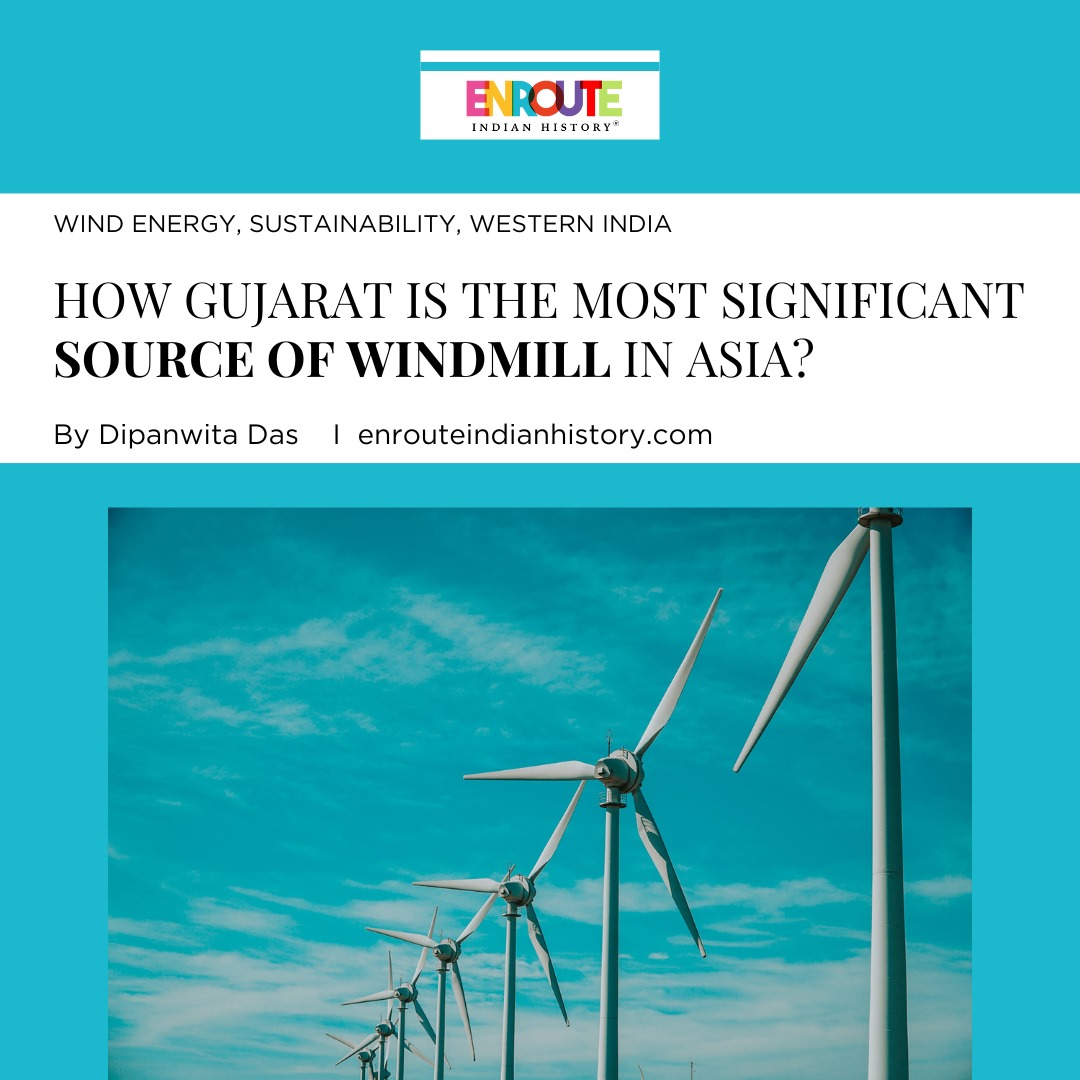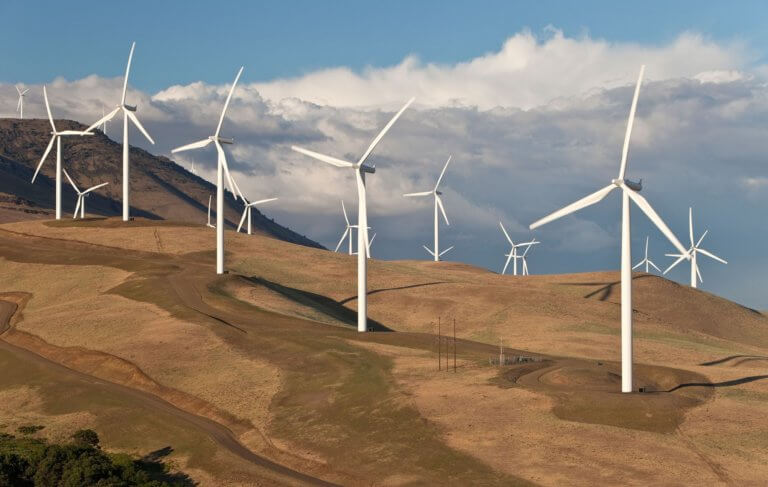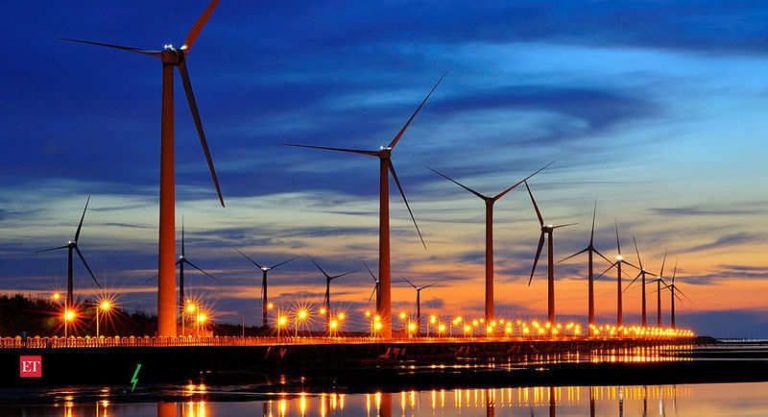
India has always been endowed with an abundance of natural resources hence it is only a matter of time before India becomes a frontrunner towards sustainable development. Wind energy refers to the kinetic energy that results from the movement of air. This energy can be harnessed and converted into useful power through the use of wind energy systems. For centuries, wind energy has been utilized for various purposes, such as sailing, grinding grain, and generating electricity. In many rural areas around the world, Windmills can be found that are used for water pumping. The use of wind power not only contributes to the generation of electricity but also promotes socio-economic development. Gujarat is home to some of the largest wind farms in Asia, with thousands of wind turbines dotting its vast landscape. The state has been a pioneer in the development of wind energy in India, and its success can be attributed to favourable climate conditions and the government’s support for renewable energy projects. The Windmills in Gujarat have helped the state to become a major player in India’s renewable energy sector. They have also brought significant economic benefits to the local communities, creating jobs and boosting the state’s economy.
Throughout human history, the power of the wind has been harnessed in a multitude of ways. In ancient Egypt, wind was a crucial element in sailing ships on the Nile River. Later on, Windmills were invented and used to grind grains like wheat into flour. The first Windmills were built in Persia and resembled large paddle wheels. Over time, the design of Windmills evolved and was improved upon by the people of Holland. They added propeller-type blades, which were still made with sails. Today, Holland is famous for its iconic Windmills, which are not only functional but also aesthetically pleasing to the eye. The blades of these Windmills gracefully rotate in the breeze, powering them to perform various tasks, from sawing timber to pumping water. Overall, wind energy has been a vital component of human history, and its continued usage in modern times is a testament to its efficiency and sustainability.

(Source: www.projectsmonitor.com)
Where do we stand?
As of January 2022, India boasts the fourth-highest wind power capacity in the world and the largest one in Asia, with 40 GW installed. Among Indian states, Tamil Nadu and Gujarat lead the pack with wind power capacities of 25% and 22% respectively. While the government has set ambitious targets of 60 GW by 2022 and 140 GW by 2030, current progress suggests that these goals may not be achieved. According to the National Institute of Wind Energy (NIWE), India has the potential to generate 302 GW of wind energy at a hub height of 100 m, and 695 GW at a hub height of 120 m. To realise the target of 140 GW by March 2030, the country needs to install over 10 GW of wind energy annually for the next decade, a goal that has yet to be achieved. In fact, annual wind installations in India have only surpassed the 5 GW mark once, in 2016-17, and have remained below 2 GW in all other years. The Windmills not only generate clean energy but also help in reducing carbon emissions, making Gujarat a more environmentally-friendly state. With the increasing demand for clean energy, the Windmills in Gujarat are likely to play an even more important role in the future of India’s energy sector.

(Source: India’s Renewable Energy Goals: Facts About Progress Made Till 2022, Titled: Installed capacity and wind potential in seven windy states at a hub height of 100m and 120m [in GW])
A Truly Environment-Friendly Alternative?
The impact of wind turbines on wildlife is often a concern, but did you know that it’s actually smaller compared to other sources of energy? In fact, conventional power stations that are fossil-fuelled, have been found to be responsible for killing 20 times more birds than wind turbines per GWh. And despite what some may think, the position of wind plants does not add significantly to the decrease in bird mortality rate. However, turbines with lower hub heights, shorter rotor diameter (higher revolution rate), and tighter turbine spacing lead to the killing of a more significant number of birds. It’s not just wind turbines that pose a problem to birds; power lines also contribute to the issue. Studies conducted globally have shown that a great number of birds die each year through electrocutions and collisions with power lines and Windmills. In Porbandar, Gujarat state, researchers surveyed Windmills and associated power lines located near some important wetlands (Important Bird Area) from May 2016 to January 2017. The study revealed the collision and electrocution of birds by power lines and Windmills is of conservation concern in Porbandar. The most affected species were Pelicans, Storks, Cranes, Pea-fowls, and Raptors.
However, there is hope. There are newly developed turbines with tubular steel towers that are safer and produce twice the energy than prop-style turbines. And in states like Texas (US), avian radars are used to detect birds in an area. If there is any risk to the passing birds, the system will stop the wind turbines immediately and restart them after the birds have passed the wind farm carefully. It’s crucial to keep in mind that the ecological importance of the landscape must not be overlooked. During the survey in Porbandar, it was discovered that of all the birds, 73 species (66%) represent aquatic and 39 species (35%) migratory. This highlights the significance of the landscape, and the need to protect it while harnessing the power of wind energy.

(Source: Ostro Kutch Wind Private Limited, www.renewablewatch.in)
References
Adani Green Energy Completes Operationalization of 300 MW Wind Power Project in Gujarat.” Adani Green Energy, 14 March 2024, www.adanigreenenergy.com/newsroom/media-releases/adani-green-energy-completes-operationalization–of-300-mw-wind-power-project-in-Gujarat.
Admin. “Adani Green Energy Commissions 100 MW Gujarat Wind Power Project.” India’s First News Website on Projects Investment, 8 Mar. 2021, www.projectsmonitor.com/daily-wire/adani-green-energy-commissions-100-mw-Gujarat-wind-power-project.
Alluri, Satya Kiran Raju, et al. “Offshore Wind to Meet Increasing Energy Demands in India.” Current Science, vol. 113, no. 4, 2017, pp. 774–81. JSTOR, http://www.jstor.org/stable/26293922. Accessed 12 May 2024
Bhatti, Jasleen, and Binit Das. “WIND ENERGY.” INDIA’S RENEWABLE ENERGY GOALS: FACTS ABOUT PROGRESS MADE TILL 2022, edited by Sunita Narain et al., Centre for Science and Environment, 2022, pp. 33–54. JSTOR, http://www.jstor.org/stable/resrep40015.5. Accessed 12 May 2024.
Kumar, J. Charles Rajesh, et al. “Wind Energy Programme in India: Emerging Energy Alternatives for Sustainable Growth.” Energy & Environment, vol. 30, no. 7, 2019, pp. 1135–89. JSTOR, https://www.jstor.org/stable/26783942 . Accessed 12 May 2024.
Natarajan, Mrs Radha. “Wind Energy and Solar Energy as Alternate Energy Sources with Particular Reference to India.” Alternative Energy Sources (2005):
Online, Et. “Adani New Industries Ltd commissions India’s largest wind turbine at Mundra, Gujarat.” Economic Times, m.economictimes.com/industry/renewables/adani-new-industries-ltd-commissions-indias-largest-wind-turbine-at-mundra Gujarat/amp_videoshow/95377872.cms
Singh, Bharat Raj, and Onkar Singh. “Uses Of Wind Power As A Non Conventional/Renewable Energy Source Towards Future Sustainability.”
Suthar, Akshit R., et al. “Impact of Windmills and power lines on birds: A case study at Porbandar Taluka, Gujarat-India.” International Journal of Fauna and Biological Studies4 (3) (2017): 93-99.



















